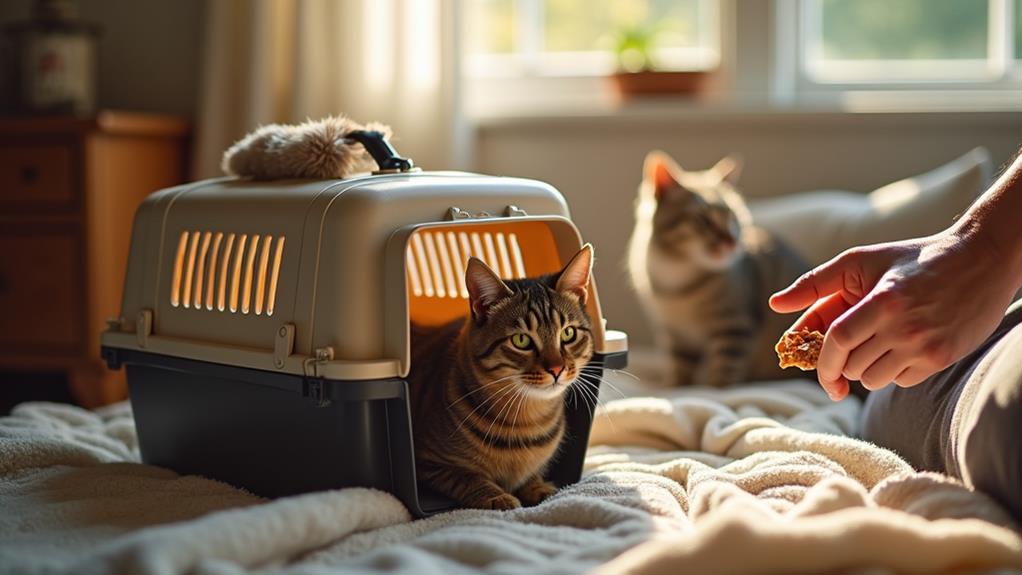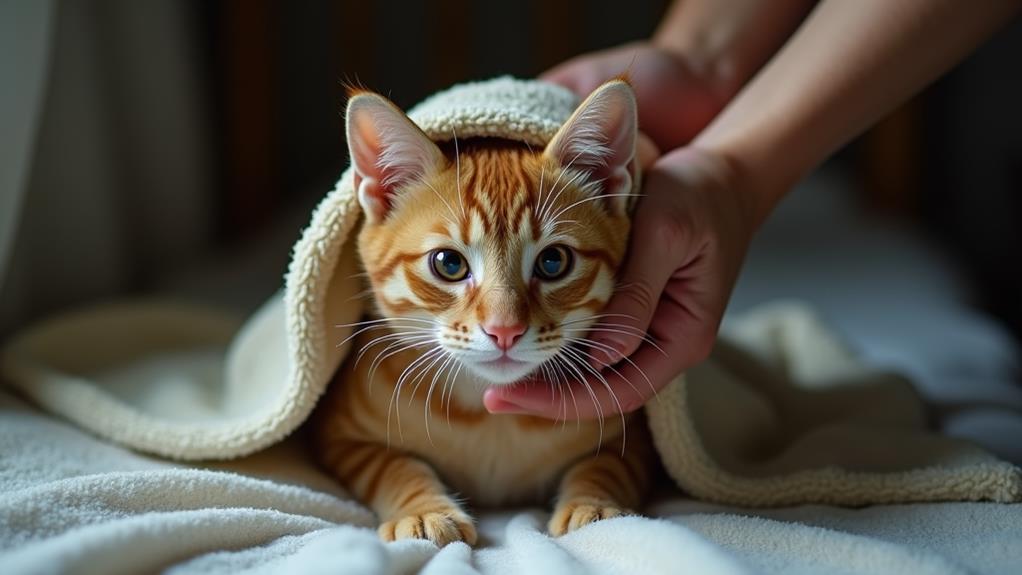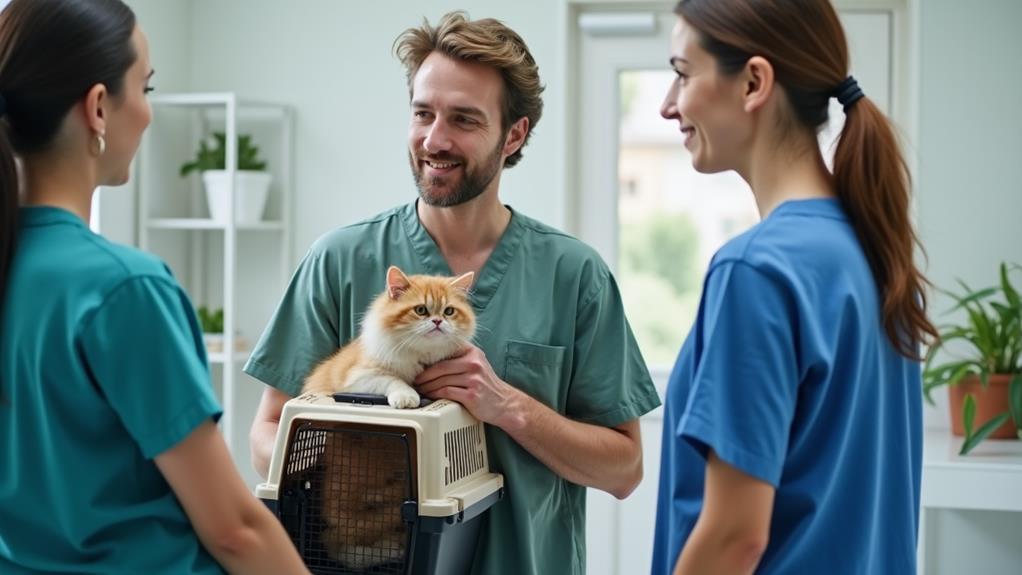How to Take a Feral Cat to the Vet: Handling and Transport Tips

To take a feral cat to the vet, start by respecting their natural instincts and using gentle handling techniques. Choose a sturdy, top-opening carrier lined with soft bedding and gradually acclimate the cat with treats. Wear gloves and use a blanket to wrap the cat when trapping, minimizing stress. Cover the carrier with a blanket to create a secure environment and use pheromone sprays or soft music to calm them. Inform the vet that the cat is feral and provide any relevant health information. With these steps, you'll effectively manage the challenges of transporting a feral cat, offering more insights ahead.
Understanding Feral Cat Behavior
When you're dealing with feral cats, getting a grip on their behavior is vital. Feral cats are naturally wary and fearful of humans, which often shows through avoidance behaviors like hissing and retreating when approached. Understanding these behavioral signs is significant for safely handling and transporting them for medical care. Key body language cues include flattened ears, dilated pupils, and a low body posture, indicating a cat feels threatened and might either flee or defend itself.
To manage their strong flight response, handle feral cats gently and with care. This approach helps prevent escalating their fear and makes the process smoother for both you and the cat. Understanding their body language and respecting their space can facilitate safer interactions. Over time, regular exposure to humans can lead some feral cats to become more tolerant or even friendly, though this varies widely among individuals.
For successful transportation, recognizing these signs helps you tailor your approach. By observing and respecting a feral cat's boundaries, you increase the chances of a successful capture and transport, ensuring they receive the medical care they need without undue stress or risk.
Preparing the Transport Carrier
To guarantee a smooth and stress-free transport of a feral cat, start by carefully choosing a sturdy, well-ventilated carrier. Opt for a transport carrier that's spacious enough for the feral cat to move around comfortably. A top-opening option is ideal, allowing easier access when needed. Once you've chosen the right carrier, place it in a secure location where the cat feels at ease. Gradually acclimate the feral cat to the carrier by encouraging exploration with food rewards. This positive association can help the cat feel more comfortable and reduce its anxiety.
Next, line the carrier with soft bedding or a familiar blanket to create a secure and inviting haven. The familiar scent and comfort of the bedding will help diminish stress during travel. To further ease the cat's anxiety, cover the carrier with a blanket or towel. This will create a dark, secure environment, making the cat feel hidden and more relaxed.
Techniques for Safe Handling

After preparing the transport carrier, it's essential to focus on handling the feral cat safely. To start, always wear gloves. This protects you from bites or scratches and helps keep the cat calm by minimizing any unexpected touch. When you trap a feral cat, use a blanket or towel to gently wrap it. This provides security by limiting its movement and reducing agitation. If you're unsure about handling, consider reaching out to a local animal rescue organization for guidance.
Acclimate the cat to the carrier by placing it in a familiar setting with some food nearby. This allows the feral cat to investigate it at its own pace before you attempt to close the door. Once inside, cover the carrier with a blanket. This creates a dark, secure space, helping to keep the cat calm during transport.
Maintain a calm demeanor throughout the process. Avoid sudden movements, as these can increase stress and anxiety. By keeping your actions gentle and reassuring, you'll make it easier to manage the cat. These transport tips guarantee both your safety and the cat's well-being, making the trip to the vet smoother for everyone involved.
Stress Reduction Strategies
Creating a calm environment is vital to reducing a feral cat's stress before transport. Begin by using pheromone spray around the transport carrier and the area where the cat will be, helping to ease anxiety. Soft music in the background can also create a soothing atmosphere. Gradually introduce the cat to the carrier by placing it in their familiar environment, encouraging exploration with treats and food. This will help the cat associate the carrier with positive experiences, promoting stress reduction.
When it's time for transport, use a covered transport carrier. It offers a secure, dark space that minimizes visual stimuli, keeping the cat calm. Maintaining a quiet atmosphere during the trip is essential. Avoid loud noises or sudden movements that might startle the cat, and monitor behavior closely to guarantee they remain as comfortable as possible.
Limit handling time during the process. Approach the cat calmly and gently to prevent agitation. The less you handle the cat, the better their cooperation will be. By following these strategies, you can greatly reduce stress for feral cats, making their trip to the vet a more peaceful experience for both you and the cat.
Communicating With Veterinary Staff

Once you've successfully managed the cat's stress during transport, effective communication with the veterinary staff becomes your next priority. Clearly inform them that the cat is feral, which helps them prepare for handling and anticipate any behavioral challenges. Sharing detailed information about the cat's health history and observed behaviors is vital. This assists the vet in making accurate assessments and decisions about the cat's care.
Discuss any specific concerns regarding the cat's past experiences with humans or handling. This information allows the veterinary team to tailor their approach, guaranteeing the cat's comfort and safety. It's also important to inquire about the clinic's protocols for handling feral cats, including sedation options and safety measures. This guarantees a smoother visit and minimizes stress for both the cat and staff.
Don't forget to address follow-up care and vaccination schedules with the veterinary staff. This proactive step helps maintain the cat's health after the visit. To facilitate a productive veterinary appointment, consider the following:
- Provide thorough health history and behavior details.
- Communicate concerns about handling and past experiences.
- Discuss sedation options and follow-up care plans.




